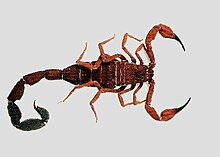| Tityus Temporal range:
| |
|---|---|

| |
| Tityus discrepans | |
| Scientific classification | |
| Domain: | Eukaryota |
| Kingdom: | Animalia |
| Phylum: | Arthropoda |
| Subphylum: | Chelicerata |
| Class: | Arachnida |
| Order: | Scorpiones |
| Family: | Buthidae |
| Genus: | Tityus Koch, 1836 |
| Species | |
|
More than 200, see text | |
Tityus is a large genus of thick-tailed scorpions (family Buthidae), the namesake of its subfamily Tityinae. As of 2021, Tityus contains more than 220 described species distributed in Central America and South America, from Costa Rica to Argentina.[1][2] Species in the genus Tityus have been studied for hundreds of years, long before the taxonomic classification was put in place. Tityus tend to be of medium size for scorpions, roughly 50 to 70 millimeters long.[3] They are dark brown or red in color, and can exhibit sexual dimorphism.[3] They can live in a variety of environments, ranging from urban to arid mountains to the Amazon Rainforest. Tityus scorpions are best known for their venom and potent sting.[4][5] The genus contains several dangerously venomous scorpions, the best known of which is the Brazilian yellow scorpion, T. serrulatus. Its venom can cause severe illness (including pancreatitis), and in the young, old and infirm even death.[6] Some experts have argued that the genus as a whole may be paraphyletic, which could explain the knowledge gaps related to Tityus. [3][5]
- ^ Rein, Jan Ove (2021). "Buthidae". The Scorpion Files. Retrieved April 4, 2021.
- ^ Jimmy A. Guerrero-Vargas, Caroline B. F. Mourão, Verónica Quintero-Hernández, Lourival D. Possani & Elisabeth F. Schwartz (2011). "Identification and phylogenetic analysis of Tityus pachyurus and Tityus obscurus novel putative Na+-channel scorpion toxins". PLoS ONE. 7 (2): e30478. Bibcode:2012PLoSO...7E0478G. doi:10.1371/journal.pone.0030478. PMC 3280238. PMID 22355312.
{{cite journal}}: CS1 maint: multiple names: authors list (link) - ^ a b c Santos, Maria Dulcineia dos; Porto, Tiago Jordão; Silva, Rejâne Maria Lira da; Brazil, Tania (2014-08-15). "Description of the male of Tityus kuryi Lourenço, 1997 and notes about males of Tityus stigmurus (Thorell, 1877) and Tityus serrulatus Lutz & Mello, 1922 (Scorpiones, Buthidae)". ZooKeys (435): 49–61. Bibcode:2014ZooK..435...49D. doi:10.3897/zookeys.435.6694. ISSN 1313-2970. PMC 4141186. PMID 25152686.
- ^ Bucaretchi, Fábio; Fernandes, Luciane C. R.; Fernandes, Carla B.; Branco, Maíra M.; Prado, Camila C.; Vieira, Ronan J.; De Capitani, Eduardo M.; Hyslop, Stephen (2014-10-01). "Clinical consequences of Tityus bahiensis and Tityus serrulatus scorpion stings in the region of Campinas, southeastern Brazil". Toxicon. 89: 17–25. doi:10.1016/j.toxicon.2014.06.022. ISSN 0041-0101. PMID 25011046.
- ^ a b Mendoza-Tobar, Leydy Lorena; Meza-Cabrera, Ivonne Alejandra; Sepúlveda-Arias, Juan C.; Guerrero-Vargas, Jimmy Alexander (November 2021). "Comparison of the Scorpionism Caused by Centruroides margaritatus, Tityus pachyurus and Tityus n. sp. aff. metuendus Scorpion Venoms in Colombia". Toxins. 13 (11): 757. doi:10.3390/toxins13110757. ISSN 2072-6651. PMC 8625436. PMID 34822541.
- ^ Daniel Strickman, Stephen P. Frances & Mustapha Debboun (2009). Prevention of Bug Bites, Stings, and Disease. Oxford University Press. p. 236. ISBN 978-0-19-536578-8.